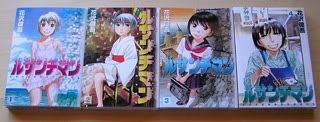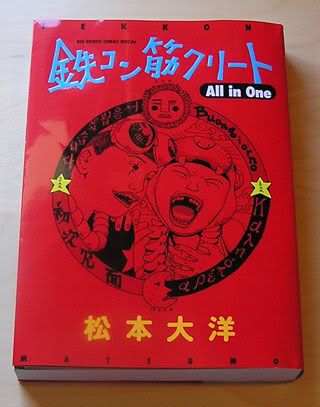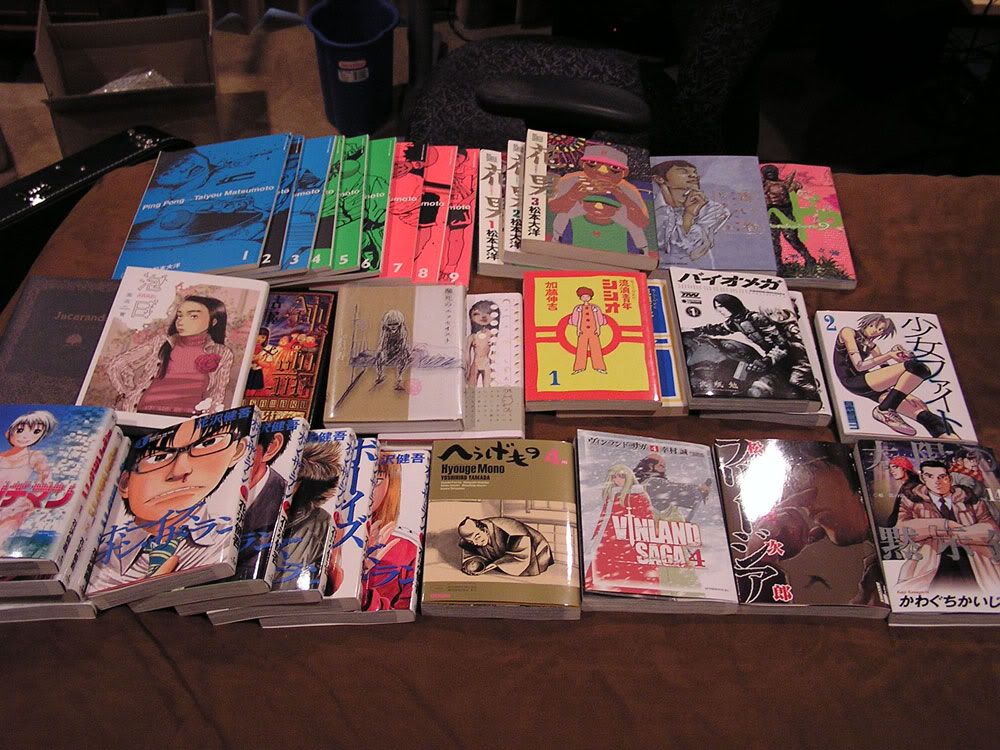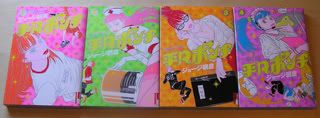
Ressentiment (ルサンチマン)
by Kengo Hanazawa (花沢健吾)
published in Big Comic Spirits (Shogakukan)
4 volumes (2004-2005)
Amazon.jp
In an earlier review of a Big Comic Spirits title, I said that I had a bad tendency to write off BCS series due to a rash of what I like to call "man-boy" seinen series, manga that are no more sophisticated or demanding than simple shonen material, only with plenty of tits and gore to appeal to intellectually stunted men. This, I admit, is a false charge; if any Shogakukan magazine deserves that label, it's Young Sunday, which is much closer to man-boy status than BCS (a sister publication of middle-aged Big Comic). Kengo Hanazawa's Ressentiment is another reason for me to regret this hasty stereotyping, for I often stared the title in the face when browsing the list of Spirits series during its publication, and only this year have I finally been forced to read it for good and admit that I really missed out.
When discussing the topic of "otaku," there are several facets of this subculture that can be examined. The obsession with two-dimensional fictional characters. The inability to relate to other people, particularly the opposite sex. The cruel ironic joke that is moe, eliciting the desire to protect and provide from the people least capable of even taking care of themselves, a poisoned fang that keeps them from forming real personal relationships and distances themselves from reality, sucked further into the cynical economic machine that preys on unpopular men. The latest and most visible piece of work to really delve into these topics headfirst to find answers is perhaps Welcome to the NHK, but Ressentiment differs from it in several key ways.
Set in 2015, Ressentiment's principle conceit is that consumer computing and AI development have reached the point that "girl games" (dating/sex simulations) are now done with VR technology, and the girls are so advanced that they might as well be human. The main character, Takuro, is a fat, ugly, balding 30-year-old man living a barren, empty life. Unlike NHK, in which the lead is a hikikomori fully trapped in the snares of otaku culture, Ressentiment's Takuro is not an otaku, just a loser who never talks to women, content to use his yearly bonus from his paper company job at a soapland brothel. Feeling panicked by the onset of his 30s and intrigued by the insistence of his old friend (a true otaku) that VR girls are the best, he decides to make the plunge, giving up on real women forever and reliving a new adolescence with his girl of choice, Tsukiko - Takuro's VR self being based on an improved, attractive version of his high school yearbook photo. "Ressentiment" is defined as a feeling of cynicism or futility at being able to improve one's station in life, and it is this emotion which Takuro succumbs to when he decides that it is pointless hoping for anything out of real women.
Hanazawa maintains an expert balance of sentimentality and pathos, aided by plenty of slapstick humor. Takuro and Tsukiko's relationship is attractive but fake; Tsukiko is just a program and Takuro is playing an unreal and attractive version of himself. Their courting, at times awkward, raunchy, embarrassing and sweet, is intercut by Hanazawa's insistence on reminding us that none of it is real. At the most telling scenes, he pulls back the camera from VR to real life, as when Takuro, comforting a sobbing Tsukiko wailing about how lonely she was before he came to her, says "Don't worry, you're not alone." All we see is fat ugly Takuro, standing alone in his room, rubbing the shoulders of an invisible person. In another scene, the pinnacle of this hilariously heartbreaking trick Hanazawa uses so cleverly, Takuro and his uber-otaku friend Echigo stand hooked up in Echigo's apartment. Echigo delivers a speech about the glories of the VR world, wherein all those disgraces and embarrassments, the shame and inferiority they suffer in real life are turned around, where they can be attractive, popular, winners. He poses as his devilishly slick, brown-haired alter-ego Reinhart, surrounded by his fawning harem of girl game archetypes - twins, maids, tsundere (brusque girls who are sweet on the inside), young sister. In the next panel, Hanazawa pulls back to reality again, where Echigo (also fat, balding and ugly, but short to boot) is posing grandly in his dark, dingy apartment covered with anime posters, while the sounds of rough sex from the couple next door seep through the wall.
Echigo, in fact, despite being the most obvious source of humor in the story, also appears to be the coolest character for being the most comfortable with his choice. Although obnoxious and haughty in person, his chivalry and dedication to Takuro in alter-ego form is rather touching, and his significant part in the climax ensures that he is both the funniest and saddest person in Ressentiment. Of course, as the dramatic lead of the story, Takuro has no such convictions, and is forced to make a decision between the real and unreal worlds, with the pressure being applied from the "real world" side coming from his coworker Nagao, an attractive woman driven desperate by her pushy personality, a lack of meaningful relationships and the need to get married before she grows too old. This choice forms the centerpiece of the climax, and it's quite a climax indeed.
Hanazawa fleshes out his story with continual exploration and development of his science-fiction setting. It starts with fascinating explanations of the physical hows and whys of all this VR technology, the helmets, tactile gloves, cameras affixed to the corners of the room, a full body suit and a special expensive penis case for sexual encounters. As the story progresses, a background narrative develops explaining Tsukiko's very extraordinary nature, with various other characters central to the modern technology displayed coming in and out of the plot. Matters escalate until Tsukiko, her AI on a rampage, demands that Takuro make his choice (her, or Nagao?) before she takes over the entire net and nukes the world. If nothing else, it makes for a bombastic love story, where one person's romance not only dictates the entire world as seen through their own eyes, but for everyone else in the world as well.
What is most impressive about Ressentiment is how deftly and solidly all these disparate elements are crammed into a rather small amount of space. Unlike Boys on the Run, Hanazawa's current ongoing series, which is completely open-ended and on pace to be several times the length of the four books here, Ressentiment is very tightly plotted and carefully maintained. One senses a lot of Hanazawa himself in this manga, and the very meticulous locations and settings provide a stronger background for his story. Boys on the Run is similar in general feel, but with a more "normal" protagonist and no sci-fi, it seems more likely to find a mainstream audience. I have no clue how popular Ressentiment was within Big Comic Spirits, but it seems likely that if it did attract a readership desperate to see a fat ugly loser fumble his way through bizarre romances, it clearly wasn't large enough to sustain the series for longer than necessary. Which is a good thing when it creates such an excellent investment for your time and money.



